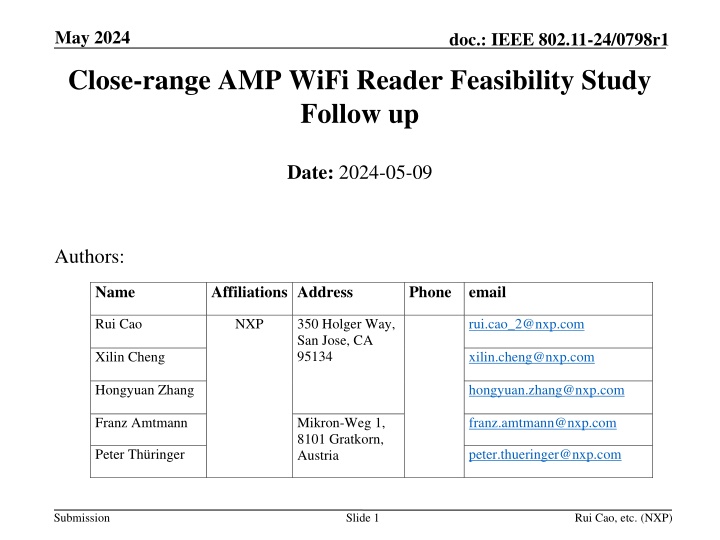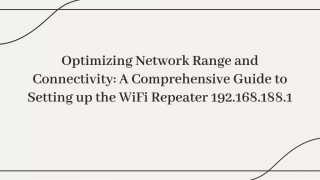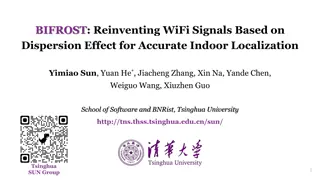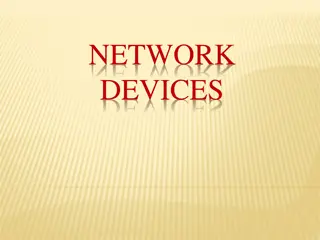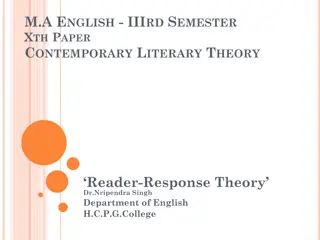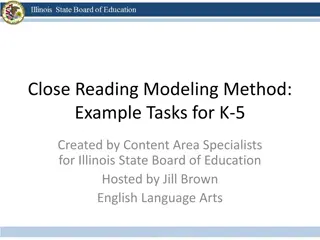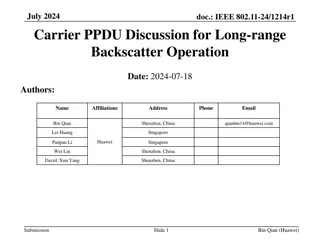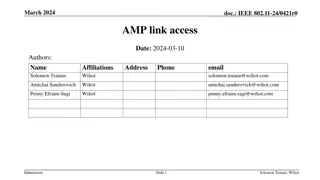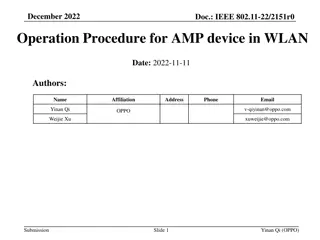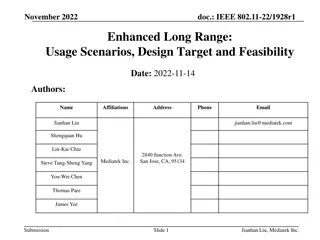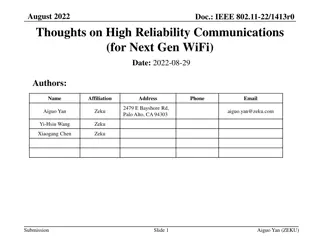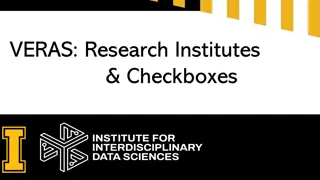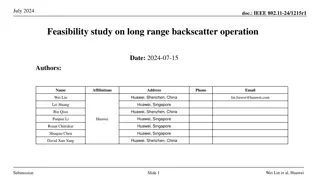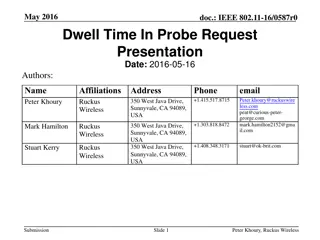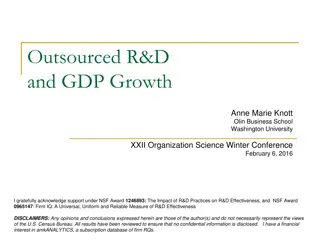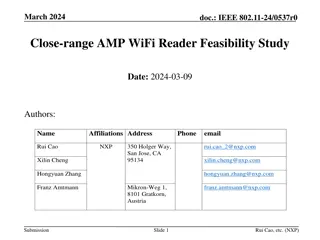AMP Close-range WiFi Reader Study
In May 2024, a feasibility study on AMP close-range WiFi reader performance was conducted by authors affiliated with NXP and Mikron-Weg. The study focused on evaluating the performance of AMP backscattering tag readers, considering factors like clock inaccuracy of the tag, waveform/PPDU requirements for tag reading and writing. The presentation highlighted the use cases for reading billions of AMP+UHF tags with mobile devices, UHF operation scenarios, and WiFi AMP tag reading, emphasizing the reading range requirements. Detailed assessments were made on signal leakage, backscattered signal, tag modulation, and backscattering modulation techniques for low-power and low-cost tag implementations.
Download Presentation

Please find below an Image/Link to download the presentation.
The content on the website is provided AS IS for your information and personal use only. It may not be sold, licensed, or shared on other websites without obtaining consent from the author.If you encounter any issues during the download, it is possible that the publisher has removed the file from their server.
You are allowed to download the files provided on this website for personal or commercial use, subject to the condition that they are used lawfully. All files are the property of their respective owners.
The content on the website is provided AS IS for your information and personal use only. It may not be sold, licensed, or shared on other websites without obtaining consent from the author.
E N D
Presentation Transcript
May 2024 doc.: IEEE 802.11-24/0798r1 Close-range AMP WiFi Reader Feasibility Study Follow up Date: 2024-05-09 Authors: Name Affiliations Address Phone email NXP Rui Cao 350 Holger Way, San Jose, CA 95134 rui.cao_2@nxp.com Xilin Cheng xilin.cheng@nxp.com Hongyuan Zhang hongyuan.zhang@nxp.com Franz Amtmann Mikron-Weg 1, 8101 Gratkorn, Austria franz.amtmann@nxp.com Peter Th ringer peter.thueringer@nxp.com Submission Slide 1 Rui Cao, etc. (NXP)
May 2024 doc.: IEEE 802.11-24/0798r1 Introduction The performance of AMP close-range backscattering tag reader was evaluated [2], considering Tag modulation noise, Tx waveform noise, Tx-Rx leakage noise floor, Rx ADC bitwidth, etc. In this presentation, Performance evaluation considering the clock inaccuracy of the tag Discuss waveform/PPDU requirement for tag reading and writing. Submission Slide 2 Rui Cao, etc. (NXP)
May 2024 doc.: IEEE 802.11-24/0798r1 Recap: use cases [1] 10 s of billions of AMP+UHF tags can be read with a mobile device? UHF operation in sub-1GHz for 2B scenarios with 10+m range Consumer usage in 2.4GHz with WiFi device in close range Read range requirement: 5~10cm Submission Slide 3 Rui Cao, etc. (NXP)
May 2024 doc.: IEEE 802.11-24/0798r1 Recap: WiFi AMP Tag Reading [1] WiFi AMP reader AMP tag WiFi reader: WiFi transceiver with 2+ antennas One set of antennas send reading energizer/carrier signal and Second set of antennas decode the backscattered tag signal Submission Slide 4 Rui Cao, etc. (NXP)
May 2024 doc.: IEEE 802.11-24/0798r1 WiFi Reader Rx Signal Leakage signal Backscattered signal ? = ?? ? + ?? + ?? ((? + ??) ? ? + ??,??) + ?? transmitted waveform Tx-Rx leakage channel modulated bit n transmit noise (TxEVM) receiver noise (SNR) backscattered channel modulation noise (TxEVM) Note: Power difference between leakage and backscattered signal is modeled into the channel Backscattering modulation: OOK, tag modulation clock has up to ~100k ppm Leakage signal BS signal 0 0 1 0 1 0 1 1 0 1 Submission Rui Cao, etc. (NXP) Slide 5
May 2024 doc.: IEEE 802.11-24/0798r1 Tag Backscattering Modulation Low-power and low-cost tag s clock inaccuracy is relative high, e.g. up to 100,000ppm for UHF tag. FM0 and Miller coding are specified for UHF tag modulation [3] Bit boundary is embedded in the signal transition, to assist Reader to resolve the high ppm. Submission Slide 6 Rui Cao, etc. (NXP)
May 2024 doc.: IEEE 802.11-24/0798r1 AMP Reader PPDU AMP Reader PPDU Fully coex with existing 802.11 devices Reuse existing 11b PPDU or OFDM PPDU (11a/g or later amendment) Example structure: Payload/Data symbols Reference Symbol(s) WiFi preamble Carrier Symbols WiFi preamble: provides coex and compatibility with other WiFi devices Reference symbol(s): Reader uses these symbols to estimate the reference for the leakage carrier symbol signal for direct Tx-Rx leakage cancellation e.g. LTF symbol or fixed loading data symbol Carrier symbols: tag will modulate information on these symbols The same waveform as reference symbol, may apply random phase for spectrum control Submission Slide 7 Rui Cao, etc. (NXP)
May 2024 doc.: IEEE 802.11-24/0798r1 Simulation Settings 2x2 WiFi device in 1Tx + 1Rx mode Antenna isolation is 20dB Rx power of -20dBm Effective Rx noise floor varies from -35dBr to -50dBr Note: assume TxEVM after differential is below Rx NF AMP tag backscattering data rate: 250kbps 250kbps data rate, i.e. one-bit modulated on a 4us waveform FM0 modulation: -20 dBr Tx noise Payload: 1000 bits WiFi reader Rx BW = 40MHz, 10-bit ADC Fixed AGC gain to get I/Q samples Leakage removal using reference symbols Matched filter to detect modulation boundary Leakage signal: 0dBr BS signal level: e.g. -30dBr Rx noise floor: e.g. -45dBr Submission Slide 8 Rui Cao, etc. (NXP)
May 2024 doc.: IEEE 802.11-24/0798r1 WiFi AMP tag reading performance Pathloss modeling uses Friss model is as in [1] RxNF=-35dBr, read a tag within ~12cm with 100,000 ppm; RxNF=-40dBr, read a tag within ~16cm with 100,000 ppm; Submission Slide 9 Rui Cao, etc. (NXP)
May 2024 doc.: IEEE 802.11-24/0798r1 WiFi AMP tag reading performance RxNF=-45dBr, read a tag within ~22cm with 100,000 ppm; RxNF=-50dBr, read a tag within ~26cm with 100,000 ppm; Submission Slide 10 Rui Cao, etc. (NXP)
May 2024 doc.: IEEE 802.11-24/0798r1 Reader to Tag Writing PPDU Discussions For Reader to Tag communication, OOK is the only modulation feasible PPDU needs to coex with existing 802.11 devices Can reuse existing WUR PPDU or new PPDU with similar structure Example: Legacy preamble WUR/New preamble OOK modulated payload Legacy preamble: provides coex and compatibility with other WiFi devices WUR/New preamble: to sync with tag Payload: information to be programmed to the tag Bit modulation can be similar to UHR Tag, PIE modulation. Submission Slide 11 Rui Cao, etc. (NXP)
May 2024 doc.: IEEE 802.11-24/0798r1 Summary Continue the evaluation of WiFi AMP reader performance considering the tag clock inaccuracy. Tag reading is feasible (<1% PER) with FM0 modulation 6~15cm range penalty for high ppm (100,000ppm) tag. WiFi AMP reader carrier PPDU Reuse existing 11b or OFDM PPDU: fully coex with existing WiFi Redefine payload portion to support reading function WiFi AMP reader to tag PPDU Need to fully coex with existing WiFi Can reuse PPDU format similar to existing 11ba WUR PPDU Submission Slide 12 Rui Cao, etc. (NXP)
May 2024 doc.: IEEE 802.11-24/0798r1 References [1] 11-23/2038, Close Range AMP Backscattering in 2.4GHz [2] 11-24/0537, close-range-backscattering-feasibility-study [3] EPC UHF Gen2 Air Interface Protocol | GS1 Submission Slide 13 Rui Cao, etc. (NXP)
May 2024 doc.: IEEE 802.11-24/0798r1 SP Do you agree to add the following text to TGbp SFD? 11bp defines MAC and PHY for close-range backscattering communication. Submission Slide 14 Rui Cao, etc. (NXP)
